Introduction
In the ever-evolving landscape of e-commerce, efficient product management is a cornerstone of success. Magento 2, a leading e-commerce platform, offers robust tools for managing product data, but understanding the intricacies of the import process is crucial. This article delves into the essential steps and best practices for importing products into Magento 2, from preparing your CSV file to troubleshooting common errors.
By following a systematic approach, businesses can ensure a seamless product import process, maintaining data integrity and enhancing overall operational efficiency. Whether starting with simple products or tackling more complex configurations, this guide provides authoritative insights to help e-commerce professionals navigate the intricacies of Magento 2 product imports.
Understanding Magento 2 Import Prerequisites
Before you initiate the product import process in Magento 2, it's essential to ensure that several prerequisites are met to guarantee a smooth and successful migration:
- Magento 2 Installed: Confirm that you have a fully functional Magento 2 installation. This is the foundation on which all your e-commerce operations will run.
- Backup: Always back up your database and files. This precautionary measure is essential to avoid any information loss during the transfer process. Effective data management is vital, as the global B2B eCommerce market is projected to grow at a CAGR of 20.2% from 2023 to 2030.
- User Permissions: Ensure that your user account has the necessary permissions to carry out uploads. This prevents any permission-related errors that could interrupt the transfer process.
- CSV File Ready: Prepare your CSV file containing the product information you wish to bring in. Ensure that the information is well-organized and validated, akin to how Magento Business Intelligence structures and presents vast amounts of eCommerce details into actionable insights.
These steps are fundamental in managing a stable and efficient Magento platform, enabling you to focus on growing your business and staying ahead in the competitive eCommerce landscape.
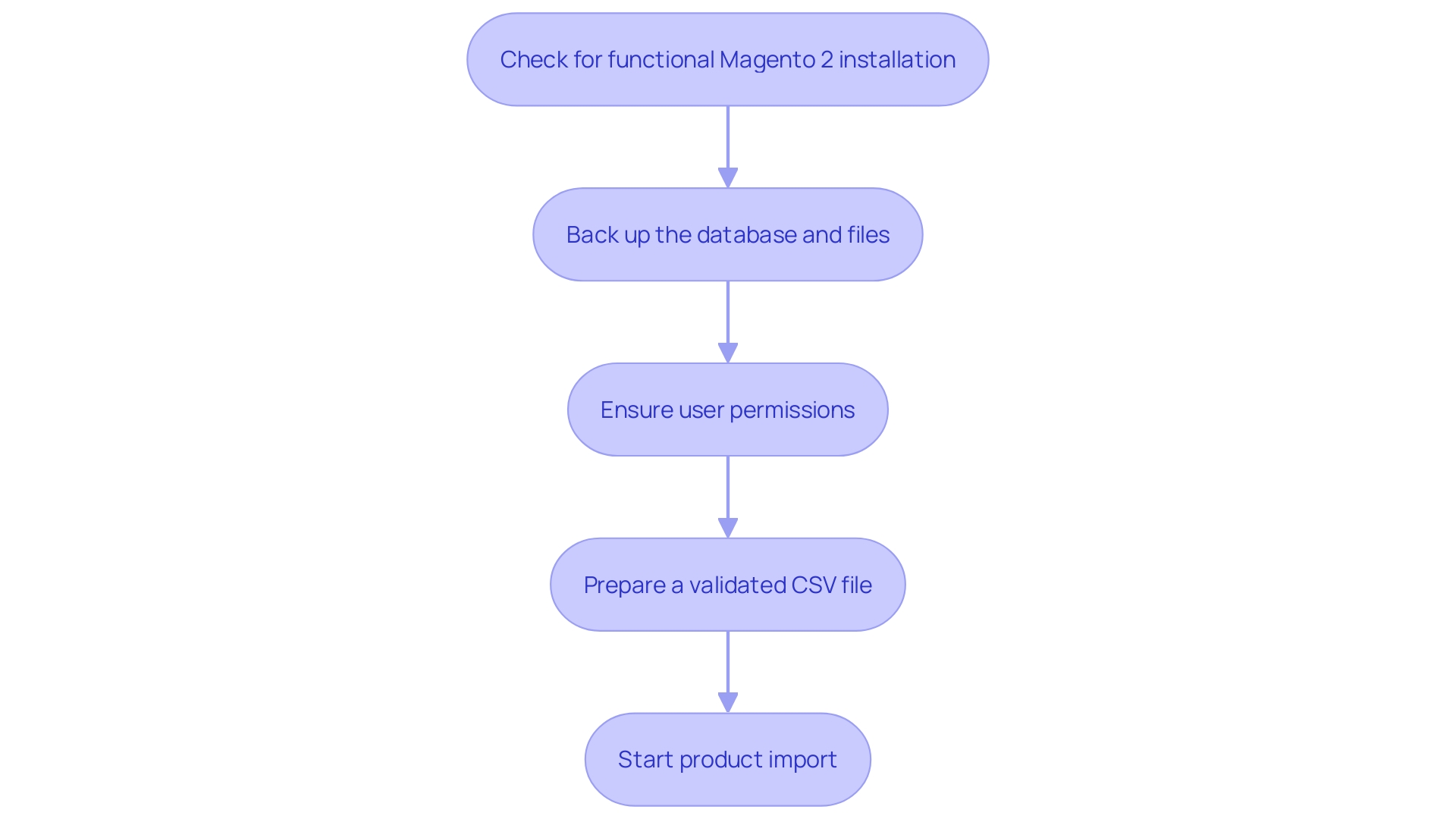
Preparing the CSV File for Import
Generating a correctly structured CSV file is crucial for successful information transfer. Follow these steps to ensure a smooth process:
-
Use a Spreadsheet Application: Utilize software like Excel or Google Sheets to create your CSV file. These tools are widely used and provide a user-friendly interface for managing your information.
-
Column Headers: Include necessary column headers such as SKU, Name, Description, Price, and other relevant fields. Appropriate headers guarantee that your information is accurately aligned during the transfer procedure.
-
Information Validation: Verify your entries, ensuring all necessary fields are filled accurately. Precise information entry is essential to prevent typical transfer mistakes and uphold information integrity.
-
Save as CSV: Save your completed file in CSV format, ensuring it is UTF-8 encoded. This encoding standard helps prevent issues with special characters and ensures compatibility with various systems.
By adhering to these steps, you can reduce mistakes and simplify your data entry workflow, guaranteeing that your information is dependable and prepared for use.
Magento 2 CSV File Structure Explained
Understanding the structure of the CSV file is crucial for a seamless import process:
- Mandatory Fields: Key fields such as SKU, Name, and Price are essential for every product. These fields act as the basis for your database, ensuring that all vital information is consistently captured and easily accessible.
- Additional Attributes: Enhance your listings by including extra attributes like weight, dimensions, and custom options. These attributes enhance your product information, offering a thorough perspective that can guide decision-making across different departments, from sales to supply chain management.
- Format Consistency: Ensure that information formats are uniform, such as using consistent date formats and decimal points for prices. This consistency is vital for maintaining data integrity and preventing errors during the import process.
A robust inventory database is indispensable for any e-commerce platform. It acts as the sole source of truth for anyone requiring information about offerings, empowering teams, educating customers, and energizing systems across the business spectrum. Precise and thorough information about offerings fuels all functions, including sales, marketing, operations, and compliance. By carefully organizing your CSV file with required fields, extra attributes, and uniform formats, you prepare for a seamless and effective transfer.
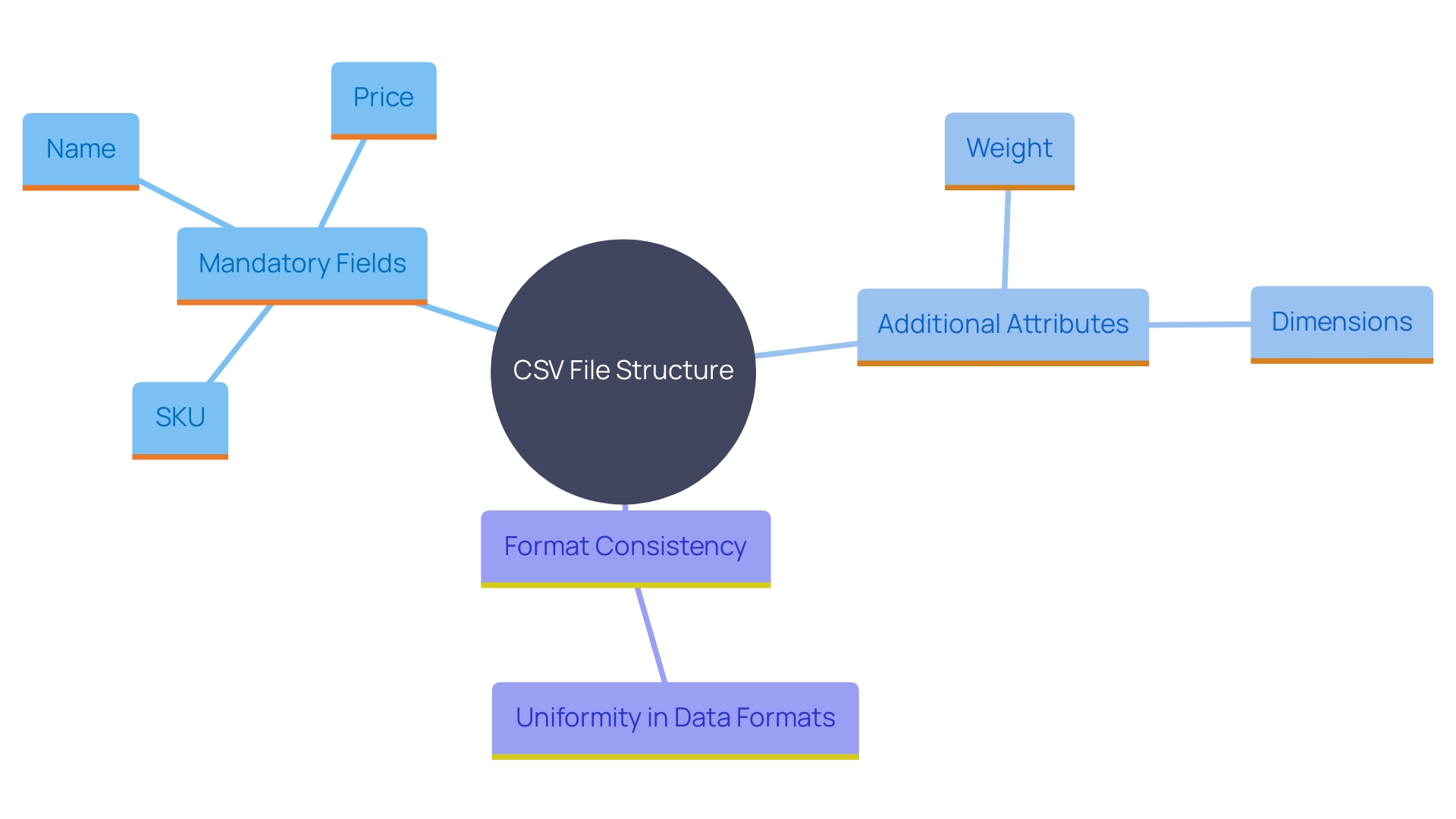
Importing Products in Magento 2: A Step-by-Step Guide
To successfully import products into Magento 2, follow these comprehensive steps:
- Access Admin Panel: Begin by logging into your Magento 2 admin panel. This is your control center for managing all aspects of your online store.
- Navigate to Import: Head to System > Import, where you can begin adding new products.
- Select Entity Type: Choose ‘Products’ from the Entity Type dropdown menu. This tells Magento what kind of data you are importing.
- Upload CSV: Click on ‘Choose File’ to upload your prepared CSV file. Ensure your file is formatted correctly to avoid issues later.
- Check Data: Click on ‘Check Data’ to validate the CSV format. Magento will scan the file for any inconsistencies or errors.
- Import: If the validation is successful, click on ‘Import’ to begin the import process. This step will include the new items in your Magento 2 store.
The smooth incorporation of new offerings into your e-commerce platform is vital for sustaining a competitive advantage in the swiftly expanding online retail industry. As more shoppers shift to online retail, keeping up with effective merchandise acquisition methods can greatly improve your store's performance.
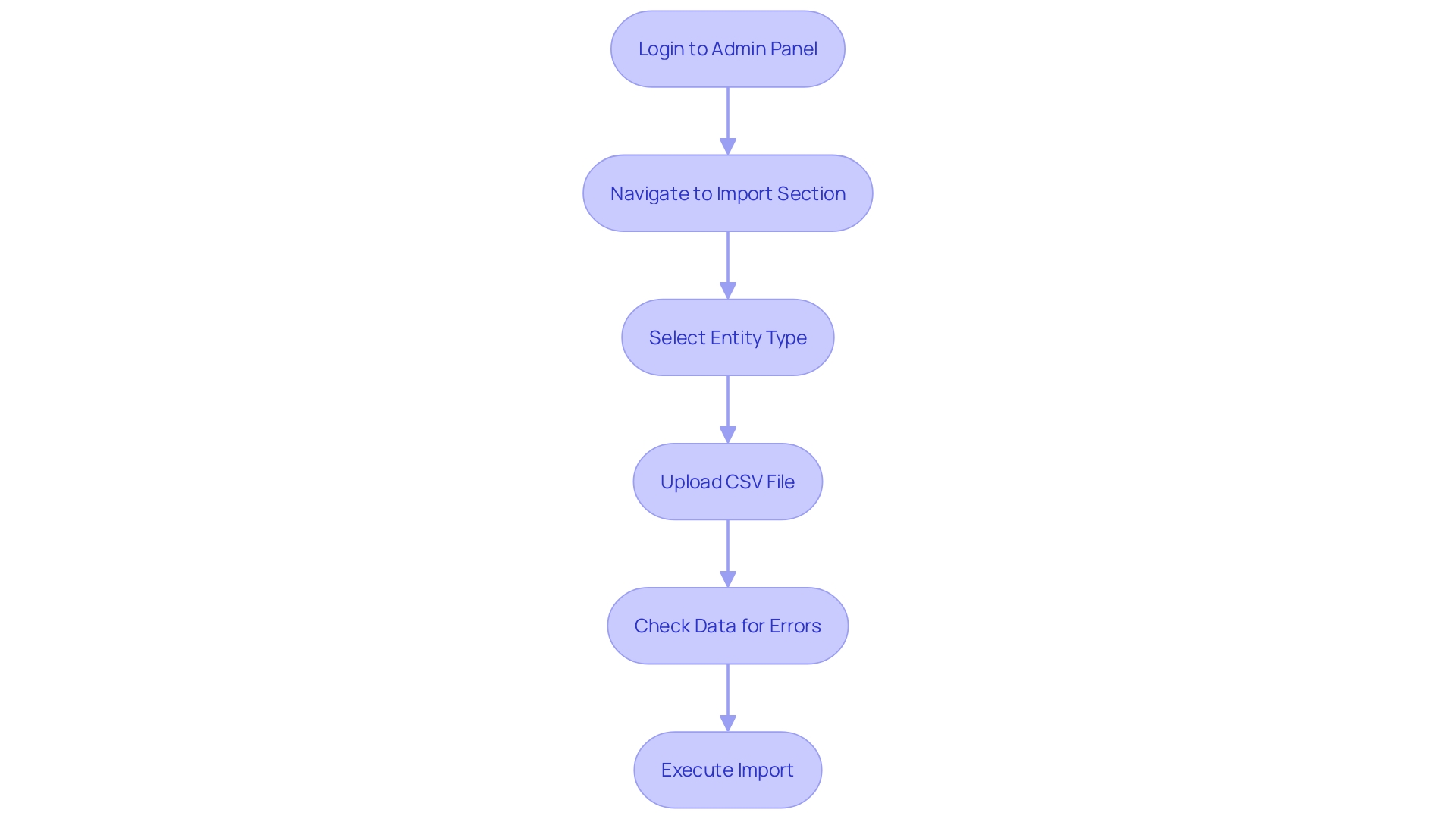
Troubleshooting Common Import Errors
Importing products into Magento 2 can often present a series of challenges, but understanding these common issues and how to address them can significantly streamline the process:
-
Validation Errors: Ensuring your CSV file adheres to Magento's formatting standards is crucial. Every mandatory field must be accurately filled to prevent data transfer failures. As observed in several instances, even minor variations in the formatting can result in mistakes, making it crucial to verify information thoroughly before trying an import.
-
Database Constraints: One of the most common pitfalls is encountering conflicts due to existing products with identical SKUs. To avoid this, always check for duplicate SKUs in your database before importing. This preemptive step can save significant time and prevent data integrity issues.
-
Log Files: Magento offers comprehensive upload logs within its admin panel. These logs are essential for identifying particular error messages that arise during the data entry. Regularly reviewing these logs can help pinpoint the exact cause of issues, whether they stem from data formatting errors or system constraints.
By tackling these areas in advance, you can lessen many of the typical challenges that occur during goods transportation, ensuring a more seamless and effective experience.
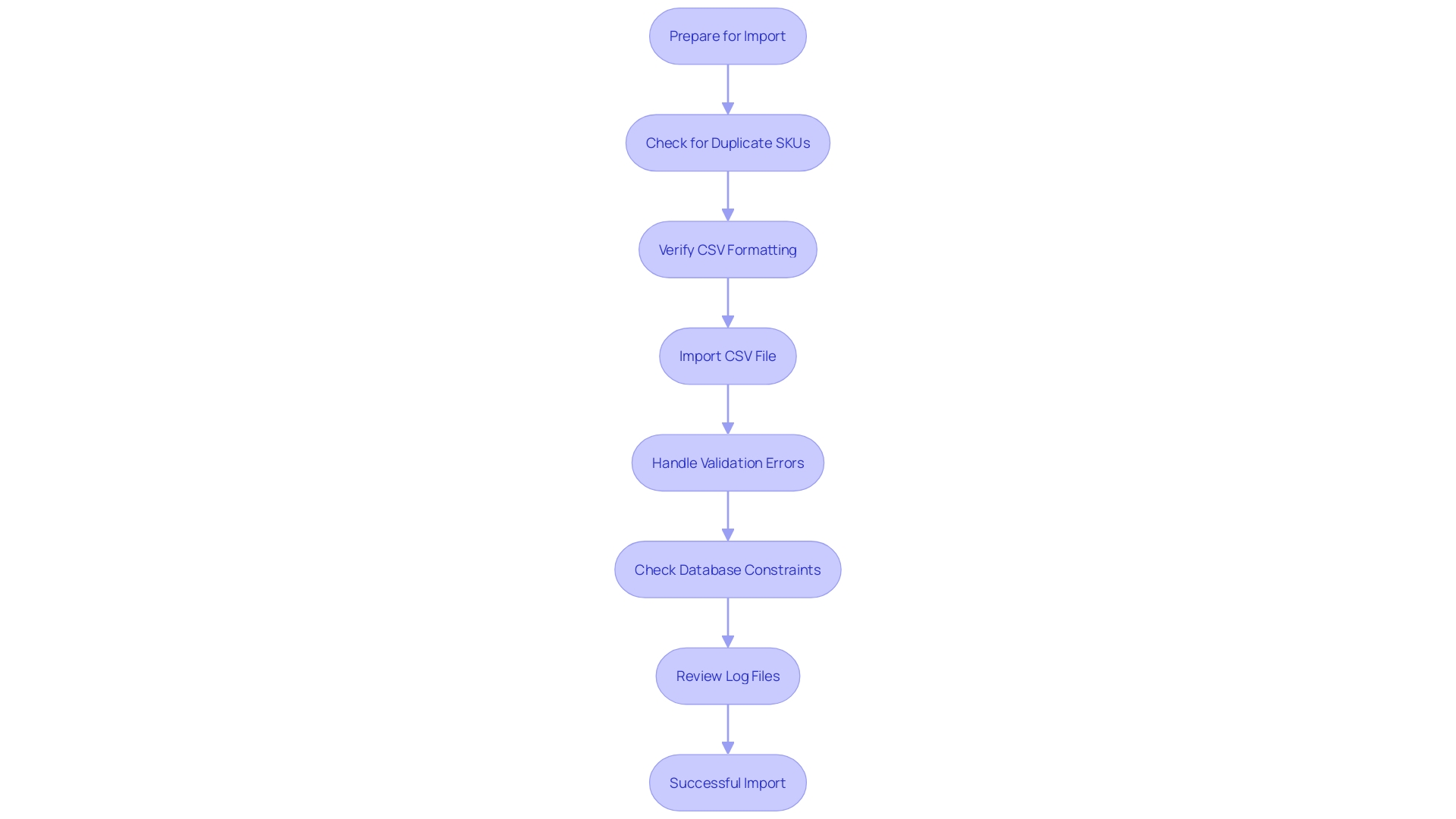
Best Practices for Magento 2 Product Import
To ensure a smooth import process in Magento 2, adhering to best practices is crucial:
- Test Upload: Start with a trial upload using a small quantity of items. This method enables you to recognize and correct potential problems prior to performing a comprehensive import, ensuring information integrity and system stability.
- Use Simple Items First: Begin by importing basic items before progressing to more intricate configurable options. 'This step-by-step process minimizes complications and aids in effectively managing product information.'.
- Regular Backups: Maintain regular backups of your database. Regular backups are essential to safeguard your data against unforeseen issues and to ensure quick recovery if something goes wrong.
- Stay Updated: Keep your Magento 2 installation updated. Leveraging the latest features and fixes not only enhances security but also improves performance and functionality, as evidenced by the significant advancements in Magento Business Intelligence and its impact on eCommerce operations.
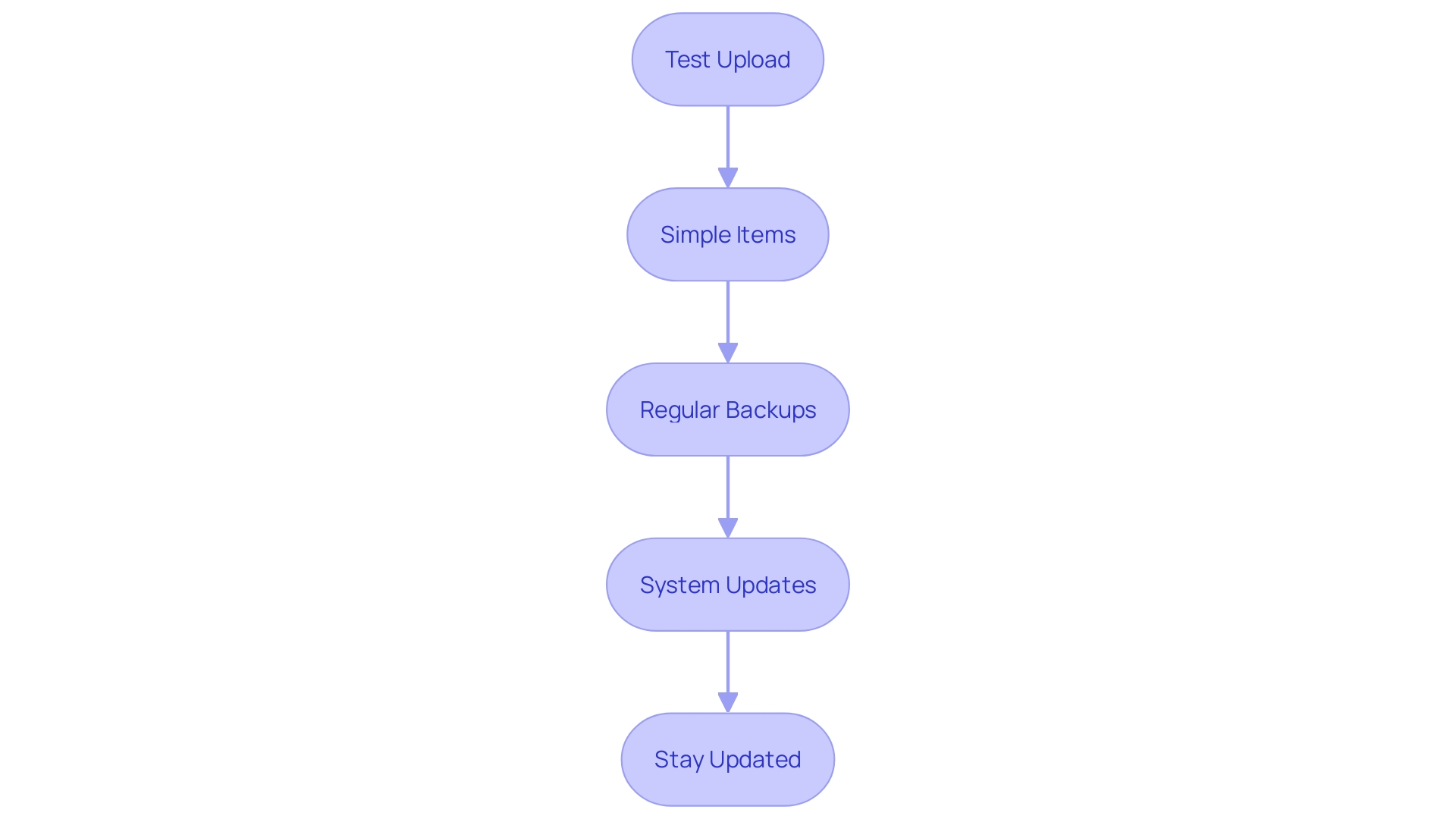
Conclusion
Efficient product management in Magento 2 is paramount for e-commerce success. By understanding the prerequisites for product import, such as ensuring a functional installation and preparing a properly formatted CSV file, businesses can lay a strong foundation for data integrity. The article emphasizes the importance of meticulous data preparation, including mandatory fields and consistent formatting, which are essential for a seamless import process.
Navigating the step-by-step import process and addressing common errors through proactive troubleshooting can significantly enhance operational efficiency. Validation of data, attention to database constraints, and the use of import logs are critical strategies for mitigating potential challenges during the importation of products.
Implementing best practices, such as conducting test imports and maintaining regular backups, further strengthens the import process. Staying updated with the latest Magento features ensures that businesses can leverage the full potential of the platform. By adhering to these guidelines, e-commerce professionals can navigate the complexities of Magento 2 product imports, ultimately driving growth and maintaining a competitive edge in the dynamic online retail landscape.





